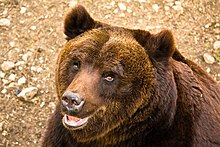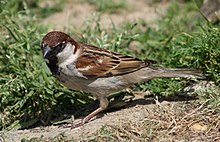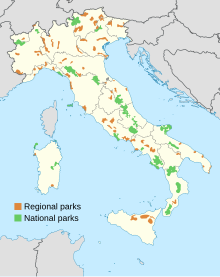Fauna of Italy
The fauna of Italy comprises all the
The fauna of Italy includes 4,777 endemic animal species, which include the Sardinian long-eared bat, Sardinian red deer, spectacled salamander, brown cave salamander, Italian newt, Italian frog, Apennine yellow-bellied toad, Italian wall lizard, Aeolian wall lizard, Sicilian wall lizard, Italian Aesculapian snake, and Sicilian pond turtle. In Italy, there are 119 mammals species, 550 bird species, 69 reptile species, 39 amphibian species, 623 fish species and 56,213 invertebrate species, of which 37,303 insect species.
Biodiversity

Italy is probably the richest European country in both plant and animal
The Italian territory extends over about 10° of latitude, therefore, while remaining in the context of temperate climates without extremes of heat, cold or aridity, the climatic difference between the north and the south of the country is not at all negligible, going from the nival climates of the Alpine peaks to the cool semi-continental temperate climate of the Po Valley, to the Mediterranean climate of the central-southern coasts and the islands.[8] Italy is predominantly hilly and mountainous in nature of the territory, which has caused a proliferation of ecological niches, close in space but very diversified.[9]
Geography and climate

Italy consists of a 1,000 km (620 miles) long peninsula extending out into the central Mediterranean, together with a number of islands to the south and west. The
Northern Italy is dominated by the Alps and an extensive valley of the
Southern Italy includes the regions of Abruzzo, Molise, Apulia, Basilicata and Campania. Agriculture and industry are less developed. The main islands are Sicily, Sardinia and the Aeolian Islands.
Because of the length of the
Ecoregions

An
Endemic species

The Checklist of the Species of the Italian Fauna includes 4,777 endemic animal species in Italy.[13]
Unique mammals include the Corsican hare, the Sardinian long-eared bat, the Apennine shrew, the Udine shrew the Calabria pine vole, and the Sardinian deer.
Endemic amphibians and reptiles include the
Endemic fishes include the
Vertebrates
Mammals
There are 119 species of mammals in Italy.[15] Some of the species are Alpine marmot, forest dormouse, Etruscan shrew (the smallest mammal in the world), European snow vole, and Schreiber's long-fingered bat. Notable large mammals are the Eurasian lynx, Italian wolf, Marsican brown bear, Pyrenean chamois, Alpine ibex, common genet, fallow deer, mouflon, rough-toothed dolphin, crested porcupine, and Mediterranean monk seal.
Birds

Italy has recorded 550 bird species.
Italy is an important route for trans-Saharan
Reptiles

About 69 species of
Amphibians
There are 39 species of
Fishes
Fish in Italy are diversified into 623 species.
Invertebrates
The Italian fauna includes 56,213 species of invertebrates, of which 37,303 species of insects.
Marine fauna

Characteristic habitat types of the Italian Mediterranean coastal zone are the
These communities host sponges (
Amongst the thousand or so species of invertebrates found in the Italian marine environment are
Strait of Messina
The
Introduced species

The Italian fauna is rich in
Examples of more recent—and sometimes unwelcome—arrivals are the
Lessepsian migration
Since the construction of the Suez Canal in 1869, invasive marine species originating from the Red Sea have become a major component of the Mediterranean ecosystem. Known as the Lessepsian migration, the introduced species have caused serious impacts on the Mediterranean ecology, endangering many local and endemic Mediterranean species. About 300 species native to the Red Sea have already been identified in the Mediterranean Sea, and there are probably others yet unidentified.
Conservation

Italy is a signatory to the Berne Convention on the Conservation of European Wildlife and Natural Habitats and the Habitats Directive both affording protection to Italian fauna and flora. National parks cover about 5% of the country,[23] while the total area protected by national parks, regional parks and nature reserves covers about 10.5% of the Italian territory,[24] to which must be added 12% of coasts protected by marine protected areas.[25]
Pleistocene fauna

The Pleistocene large mammals of Italy were primarily Eurasian immigrants fleeing extreme cold further north. Typical species are:
- Cave bear, Ursus spelaeus
- European cave lion, Panthera leo spelaea
- European hippopotamus, Hippopotamus antiquus
- Neanderthal, Homo neanderthalensis
- Woolly mammoth, Mammuthus primigenius
- Mammuthus meridionalis
- Straight-tusked elephant, Elephas (Palaeoloxodon) antiquus
- Woolly rhinoceros, Coelodonta antiquitatis
Insular dwarfism
Pleistocene dwarf elephants developed as a result of insular dwarfism on the island of Sardinia:
- Mammuthus lamarmorae(Major, 1883)
- Elephas antiquus(Acconci, 1881)
- Elephas melitensi (Caria, 1965))
On the islands of Sicily and Malta:
- Elephas (Palaeoloxodon) antiquus leonardii (Aguirre, 1969)
- Elephas (Palaeoloxodon) mnaidriensis (Adams, 1874)
- Elephas (Palaeoloxodon) melitensis (Falconer, 1868)
- Elephas (Palaeoloxodon) falconeri (Busk, 1867))
Other Pleistocene animals found on these islands are:
- Sardinian dhole, Cynotherium sardous
- Sicilian hippopotamus, Hippopotamus pentlandi
- Sardinian dwarf mammoth, Mammuthus lamarmorae
Zoological museums

Museums which contain important collections of the fauna of Italy and which have public galleries devoted to the Italian fauna are:
- Civico Museo di Storia Naturale di Trieste, Trieste
- La Specola, the Museum of Zoology and Natural History of Florence
- Museo Civico di Storia Naturale di Ferrara
- Museo Civico di Storia Naturale di Milano, Milan
- Museo Civico di Storia Naturale Giacomo Doria, Genoa
- Museo Civico di Zoologia di Roma, Rome
- Museo civico di Rovereto, Rovereto
- Museo di Scienze Naturali Enrico Caffi, Bergamo
- Museo di Storia Naturale di Firenze, University of Florence, Florence
- Museo storia naturale di Pisa, Pisa
- Museo tridentino di scienze naturali, Trento
- Turin Museum of Natural History, Turin
- Zoological Museum of Naples, Naples
- Stazione Zoologica, Naples
- Museo paleontologico di Montevarchi, Montevarchi
- Museo civico di storia naturale di Verona, Verona.
- Museo di storia naturale del Mediterraneo, Livorno
- Museo di storia naturale della Maremma, Grosseto
Zoological societies
- Ente nazionale per la protezione degli animali (ENPA)
- Lega Italiana Protezione Uccelli(LIPU)
- Unione Zoologica Italiana
- La Società Entomologica Italiana
- Societas Herpetologica Italica
- Italian Horse Protection Association
- Tethys Research Institute
See also
- Flora of Italy
- Geography of Italy
- List of extinct and endangered species of Italy
- List of amphibians of Italy
- List of birds of Italy
- List of butterflies of Italy
- List of mammals of Italy
- List of moths of Italy
- List of non-marine molluscs of Italy
- List of reptiles of Italy
- List of snakes of Italy
References
- ^ Livy (1797). The history of Rome. George Baker (trans.). Printed for A. Strahan.
- ^ Sheri Foster (January 2021). "What is Italy national animal?". Yourtrip.com.
- ^ James Hansen (June 2018). "Il lupo grigio degli appennini e l animale dell Italia". "affaritaliani.it">.
- ^ "Italy's Fifth National Report to the Convention on Biological Diversity" (PDF). Italian Ministry for the Environment, Land and Sea. p. 7. Archived (PDF) from the original on 18 May 2015. Retrieved 17 May 2015.
- ^ "La ricchezza della Biodiversità italiana" (in Italian). Retrieved 10 March 2022.
- ^ "Italy - Main Details". Convention on Biological Diversity. Retrieved 10 September 2023.
- ^ "Biodiversità" (in Italian). Retrieved 10 March 2022.
- ^ "Il clima in Italia" (in Italian). Retrieved 10 March 2022.
- ^ "La "nicchia ecologica" di Fonte Santa: storia di un microclima unico in Italia" (in Italian). Retrieved 10 March 2022.
- ^ Adriana Rigutti, Meteorologia, Giunti, p. 95, 2009.
- ^ Thomas A. Blair, Climatology: General and Regional, Prentice Hall pp. 131–132
- ^ "Ambiente: oltre 3600 specie animali nelle 40mila grotte italiane" (in Italian). Retrieved 13 March 2022.
- ^ "CHECKLIST E DISTRIBUZIONE DELLA FAUNA ITALIANA" (PDF) (in Italian). p. 29. Retrieved 10 March 2022.
- ^ "Lista Rossa delle Farfalle italiane - IUCN" (PDF) (in Italian). p. 13. Retrieved 10 March 2022.
- ^ "Mammiferi d'Italia - Ministero della Transizione Ecologica" (PDF) (in Italian). p. 7. Retrieved 11 March 2022.
- ^ "Italian House Sparrow". EBN Italia. 1 May 2015. Retrieved 10 May 2015.
- ^ "Uccelli" (in Italian). Retrieved 11 March 2022.
- ^ Peter Uetz; Jakob Hallermann; Jiri Hosek. "Distribution: italy". The Reptile Database. Retrieved 22 June 2021.
- ^ "Quali sono gli anfibi autoctoni?" (in Italian). Retrieved 11 March 2022.
- ^ "Animali anfibi: curiosità ed elenco delle specie più strane" (in Italian). Retrieved 11 March 2022.
- ^ a b "All fishes reported from Italy". Retrieved 10 March 2022.
- ^ "Dove operiamo" (in Italian). Retrieved 11 March 2022.
- ^ "National Parks in Italy". Parks.it. 1995–2010. Archived from the original on 29 March 2010. Retrieved 15 March 2010.
- ^ "Regione e aree protette" (in Italian). Retrieved 11 January 2022.
- ^ "Le aree protette in Italia" (in Italian). Retrieved 2 March 2022.
Bibliography
- Dobson, M. (1998). "Mammal distributions in the western Mediterranean: the role of human intervention". Mammal Review. 28 (2): 77–88. .
- Latella L., 2007. I Musei di Storia Naturale e la gestione del territorio, l’esempio della CKmap e il Museo di Verona. Museologia scientifica (n.s.) 1: 149-151.
- Latella L., 2011. Il ruolo dei Musei di Storia Naturale nello Studio, monitoraggio, conservazione e divulgazione della biodiversità. alcuni esempi italiani. In: Pignatti S. (ed.). Aree protette e ricerca scientifica. ETS edizioni, Pisa: 101-112.
- Minelli A., Ruffo S., La Posta S. (Eds), 1993-1995Checklist delle specie della Fauna d'Italia [Checklist of the species of the Italian Fauna] Calderini Ed., Bologna. The first complete inventory of the animal species of a whole country in Europe.Records 57,422 species (56,168 invertebrates and 1,254 vertebrates). A collaboration between the Nature Conservation Service and the Scientific Committee for the Fauna of Italy, the Italian Zoological Union and the National Academy of Entomology. 272 specialists from 15 countries were involved in the project. Species are (uniquely) identified by numerical codes. The work is divided into 110 issues.
- Minelli A., 1996 La checklist delle specie della fauna italiana. Un bilancio del progetto. Bollettino Museo Civico Storia naturale Verona, 20: 249-261.
- Minelli A, Chemin, C., R. Winch & Ruffo S. Ruffo & S.2002 La fauna in Italia. The fauna in Italy. Touring Editore, Milano e Ministero dell'Ambiente e della Tutela del Territorio, Roma. Touring Editore, Milan and Ministry for the Environment and Territory, Rome. 448 pp.
- Sindaco, R., Doria, G., Razzetti, E. and Bernini, F. 2006 (eds) Atlas of Italian Amphibians and Reptiles\Atlante Degli Anfibi E Dei Rettili D'Italia Polistampa.
- [1] Logozzo, D., Bassi, E., and Cocchi, L.. 2004. Crossing the sea en route to Africa: autumn migration of some Accipitriformes over two central Mediterranean Islands. Ring 26:71-78.
- Stoche, F., 2000 How many endemic species? Species richness assessment and conservation priorities in Italy.Belgian Journal of Entomology, 2: 125-133.
- Stoche, F., 2004 Banche dati e distribuzione della fauna italiana: gli invertebrati. Quad. Cons. Natura, 18, Min. Ambiente Ist. Naz. Fauna Selvatica: 21-36.
External links
- [2] FaunaItalia
- Fauna Europaea Archived 23 April 2008 at the Wayback Machine
- Wild Wonders of Europe Photo gallery
- biodiversityhotspots
- [3] Amphibia Web 48 Species returned for Italy
- Fishbase Returns 585 species (incomplete)
- Living Treasures Italy
- entomologiitaliani Entomology Forum. Many images. In Italian
- naturamediterraneo Forum. Many images In Italian
- European Marine Life
- Marine Research in Medina
- EBN Where to watch birds in Rome
- Biographies of famous Italian Zoologists
- Mondo Marino Photogallery Marine life 375 photos from the Mediterranean
- Scricciolo Alberto Masi Ornithology Website
- WWF
- Federazione Nazionale Pro Natura In English and Italian
- Conchiglie del Mediterraneo
- AIAM Faunal index page (Major taxa)
- Ecoregions
- Protected areas
- Scarabeoidea of Italy
